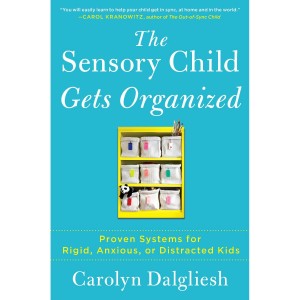The opportunity to review The Sensory Child Gets Organized by Carolyn Dalgliesh came at a great time. At almost 5, M is at an age where he is being given more responsibility for tasks around the house. Also, like many children with autism and other sensory-processing issues, he has a lot of anxiety related to changes in the world around him. We had just been discussing with his team ways to organize/alter some of M’s routine in order to better serve him when I was asked about reviewing this book. It definitely had some helpful tips!
I do have one piece of criticism that I want to get out of the way. Ms. Dalgliesh uses the term “tantrum” as though it is somehow synonymous with “meltdown.” I do have a difficult time understanding how someone professing to be knowledgeable in the realm of sensory processing issues could make this mistake. (She has a son with sensory processing issues and runs a business devoted to helping sensory families get organized.) During a tantrum, the child is in control. They are engaging in the behavior to achieve a specific endpoint. When that endpoint is resolved, the tantrum stops. For example, J wanted candy yesterday. When we told him no, he screamed, cried, and kicked his toy. We reiterated that he could have candy after dinner, and within a couple of minutes he’d moved on to the next thing. In a meltdown, the child does not have control over the situation. A meltdown might appear to be for a specific reason, or could come out of the blue. A child having a meltdown may hurt themselves or others because they are so out of control they don’t understand what they’re doing. The only thing that’s going to resolve a meltdown is time: a solution offered to whatever might have triggered the meltdown isn’t going to work. For example, M was regularly having 30 minute meltdowns every day after school. He tried to hold it together for the 2.5 hours of class, and then as soon as any “demand” was placed on him at home (for example, “come to the table for lunch”) he’d completely lose it and I’d have to carry him to his bedroom. Some changes to the after-school routine have helped these dramatically. It really bothered me that the author would use tantrum throughout the book (much more often than meltdown) when that isn’t what she actually meant. It can also be a triggering term for parents of kids with sensory processing issues as people often assume are kids are having tantrums and therefore they, and we, must have more control over them than we actually do. You can read more about the differences here.
That aside, I did enjoy the book. In some ways, it appeared to be geared towards parents who are looking for an introduction into the world of sensory processing issues. Part 1 of the book is called “Understanding Your Sensory Child,” and this is great if your child is newly diagnosed, but mostly worth skimming if you’ve been immersed in this world for a while. It breaks down the various diagnoses that could cause sensory processing problems and how those issues might manifest themselves. It also explains why sensory organizing is helpful. Make sure to note the last section: it’s a great worksheet on sensory organizing. Not only is there a blank copy for you, but she provides a completed example as well.
Part 2 of the book is titled “Helping Your Sensory Child at Home” and it was the most helpful to me. Dalgliesh breaks down parts of the home and routine that tend to be the most problematic for sensory kids and gives tips for addressing them all. She makes sure to include great visuals as well. I’m (almost, haha) looking forward to tackling M’s room using her suggestions for organizing clothes and toys! I think I’ll incorporate a version of her downstairs dressing area idea as well. In this section she also includes tips for how to handle meltdowns. Some we’ve tried before, others we have not.
Part 3 of the book is “Helping Your Sensory Child in the World.” This section covers how to tell if a situation might be troublesome for your child and how to prepare them for that, how to teach others about your child’s needs, and how to handle the schools.
This is a good reference book, one you may consult again and again as your child grows. The photographs and examples are incredibly helpful. I’d definitely recommend it to those just starting on this journey, but it has great parts for those who have been on this road awhile, too. I’m going to mention it to M’s therapists so they can have it in their arsenal to recommend to other families.
You can buy The Sensory Child Gets Organized wherever books are sold, or on Kindle. You can also connect with the author on Facebook.

